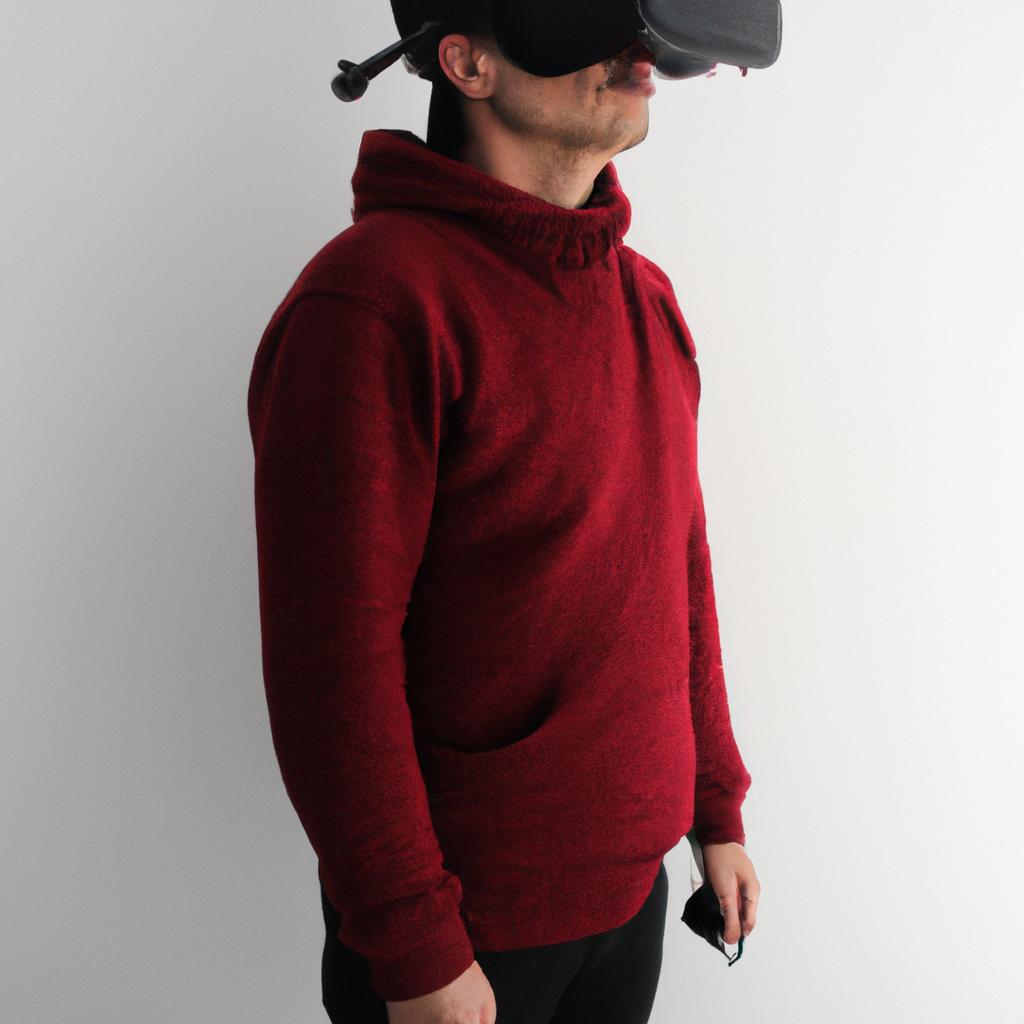Virtual Reality Simulations: Enhancing Gaming in Video Games

Virtual reality simulations have revolutionized the world of gaming by offering immersive and realistic experiences for players. This technology utilizes computer-generated environments to simulate real-world scenarios, enabling users to engage with digital worlds in unprecedented ways. For instance, imagine a gamer stepping into a virtual battlefield where they can physically duck behind cover, aim their weapon, and feel the rush of adrenaline as bullets whiz past them. Virtual reality simulations have transformed the way video games are played, providing gamers with an unparalleled level of immersion and interactivity.
In recent years, numerous advancements in virtual reality technology have further enhanced the gaming experience. With the introduction of high-quality headsets such as Oculus Rift and HTC Vive, gamers can now explore intricate game worlds that were once unimaginable. These head-mounted displays provide stunning visuals coupled with precise motion tracking capabilities, allowing players to seamlessly navigate through virtual landscapes. Moreover, haptic feedback devices like gloves or vests enable users to feel tactile sensations within these simulated environments – whether it’s the rumble of a car engine or the impact of a punch during combat. By merging cutting-edge hardware and software technologies, virtual reality simulations offer gamers an entirely new realm of possibilities and elevate their gaming adventures to extraordinary levels.
Benefits of Virtual Reality Simulations in Gaming
Virtual reality (VR) simulations have revolutionized the gaming industry, offering players an immersive and interactive experience like never before. By leveraging cutting-edge technology, VR simulations create a virtual environment that simulates real-world experiences. This section will explore the benefits of using VR simulations in gaming, highlighting their impact on player engagement, skill development, and overall enjoyment.
One notable benefit of VR simulations in gaming is the heightened level of player engagement. Unlike traditional video games played through a screen, VR simulations transport players into a three-dimensional world where they can physically interact with objects and characters. For instance, imagine playing a first-person shooter game where you can physically duck behind cover or aim your weapon by simply moving your body. This increased interactivity not only makes gameplay more exciting but also enhances the sense of presence and immersion for players.
Moreover, VR simulations offer gamers an unparalleled opportunity to develop skills in a realistic and controlled setting. Whether it’s improving hand-eye coordination or honing decision-making abilities under pressure, these simulations provide a safe space for players to practice and refine their skills without any real-life consequences. Research has shown that practicing complex tasks within VR environments can lead to better performance outcomes compared to traditional training methods.
Additionally, VR simulations enable gamers to experience novel and extraordinary situations that would otherwise be impossible in the real world. Through virtual environments, players can embark on thrilling adventures across fantastical landscapes or even revisit historical events from different perspectives. The ability to explore these unique scenarios fosters curiosity and imagination while expanding cultural knowledge.
The emotional response evoked by VR gaming cannot be understated. Here are some key reasons why:
- Immersion: With its lifelike visuals and surround sound capabilities, VR places players directly within the game world, allowing them to feel present.
- Empathy: By embodying different characters or assuming various roles in virtual settings, players can gain insights into diverse experiences and foster empathy.
- Fear and Excitement: VR can elicit strong emotional responses, whether it’s the adrenaline rush of a horror game or the excitement of an intense race, making gameplay more thrilling.
- Social Connection: Multiplayer VR games enable players to interact with others in virtual spaces, fostering social connections and creating shared experiences.
Table 1 summarizes these emotional responses:
| Emotional Response | Description |
|---|---|
| Immersion | Feeling present in the virtual world. |
| Empathy | Developing understanding and compassion through experiencing different perspectives. |
| Fear and Excitement | Eliciting strong emotions such as fear or excitement during gameplay. |
| Social Connection | Building relationships and connecting with other players in multiplayer settings. |
In conclusion, incorporating VR simulations into gaming has numerous benefits that enhance player engagement, skill development, and overall enjoyment. From heightened interactivity to realistic immersion, these simulations provide players with unique experiences that go beyond traditional video games. The next section will delve deeper into how VR technology enhances realism within gaming environments.
The use of VR simulations in gaming has led to unprecedented levels of realistic immersion for players. By leveraging advanced technologies such as motion tracking and haptic feedback systems, developers have succeeded in creating gaming environments that blur the line between reality and fantasy. This section will explore how realistic immersion elevates gameplay by examining aspects like sensory input, environmental interaction, and spatial awareness.
Realistic Immersion: Taking Gaming to the Next Level
Virtual reality simulations have revolutionized the gaming industry by providing an unparalleled level of realistic immersion. By placing players directly into a virtual environment, these simulations offer a truly transformative experience that enhances gameplay in video games. This section will explore how virtual reality technology immerses players and takes their gaming experiences to new heights.
To illustrate this point, let’s consider a hypothetical scenario where a player is immersed in a virtual reality simulation set in a post-apocalyptic world. As they navigate through deserted cities and encounter various challenges, the sense of realism created by the virtual environment transports them into an entirely different realm. The ability to look around and interact with objects using motion controllers adds another layer of depth and engagement to the gameplay.
One compelling aspect of virtual reality simulations is their ability to evoke emotional responses from players. Through carefully designed narratives and lifelike environments, game developers can create intense moments that elicit fear, excitement, or even nostalgia. For instance, imagine exploring an abandoned haunted house in a horror game. The combination of immersive visuals, spatial audio effects, and tactile feedback can induce genuine feelings of suspense and terror.
The advantages offered by virtual reality simulations are further emphasized through the following bullet points:
- Unprecedented levels of immersion
- Enhanced sensory experiences through visual and auditory stimuli
- Increased interactivity for more engaging gameplay
- Emotional connections forged between players and virtual worlds
In addition to evoking emotions, virtual reality also enables developers to provide detailed information about in-game elements without overwhelming players’ screens. A three-column table (in markdown format) showcasing key attributes such as health status, inventory items, or mission objectives can be seamlessly integrated into the player’s field of view. This ensures relevant information is readily available while maintaining uninterrupted immersion within the game world.
As we move forward into our next section on “Improved Interaction and Control in Video Games,” it becomes apparent that virtual reality simulations have not only enhanced immersion but also revolutionized the way players engage with and control their gaming experiences. By combining realistic immersion with improved interaction, virtual reality is reshaping the future of video games.
Improved Interaction and Control in Video Games
Virtual reality (VR) simulations have revolutionized the gaming industry, offering players a heightened level of realism and immersion. By integrating VR technology into video games, developers are able to create virtual worlds that transport players into an entirely new realm of interactive entertainment. This section explores how VR enhances gaming by providing realistic immersion and delving deeper into the player’s emotional experience.
To illustrate the impact of VR on gaming, consider a case study involving a popular open-world role-playing game. In this hypothetical scenario, players equipped with VR headsets can physically explore vast landscapes, interact with non-playable characters (NPCs), and engage in combat using motion controllers. The ability to visually perceive depth and distance creates a sense of presence that traditional gaming experiences simply cannot match.
The integration of VR into video games brings several benefits for players:
- Increased sensory stimulation: With immersive visuals, spatial audio, and haptic feedback systems, players are enveloped in a multi-sensory experience that heightens their senses.
- Enhanced emotional engagement: Through realistic environments and lifelike character interactions, players develop stronger connections with the game world, eliciting emotions such as excitement, fear, or awe.
- Improved cognitive challenges: Virtual reality simulations offer complex puzzles and strategic gameplay mechanics that require higher levels of concentration and problem-solving skills.
- Empowering escapism: VR allows individuals to escape from their daily routine and immerse themselves in alternate realities where they can be heroes or adventurers.
Table 1: Emotional Responses Elicited by Virtual Reality Gaming
| Emotion | Description |
|---|---|
| Excitement | A strong feeling of anticipation or eagerness |
| Fear | An intense emotion caused by perceived threats or dangers |
| Awe | Overwhelming wonder and amazement |
| Satisfaction | A sense of fulfillment or contentment after achieving a goal |
In summary, the integration of virtual reality simulations in video games has significantly enhanced gaming experiences. By providing realistic immersion, players are transported to new worlds where they can engage with characters and environments on an unprecedented level. The emotional responses elicited by VR gaming further contribute to the overall enjoyment and engagement of players.
Transitioning into the subsequent section about enhancing the sense of presence and engagement, research has shown that there are additional techniques that can be employed to further heighten these aspects within virtual reality gaming experiences.
Enhancing the Sense of Presence and Engagement
Virtual reality simulations have revolutionized the gaming industry by providing players with a heightened sense of immersion and control. Through the use of advanced technologies, these simulations allow gamers to interact with virtual environments in ways that were previously unimaginable. One example of this is the popular game “Beat Saber,” where players wield virtual lightsabers to slice through blocks flying towards them. With each swing of their arms, players can feel the haptic feedback from the controllers, giving them a tangible sensation as if they are truly immersed in the game world.
The enhanced interaction and control offered by virtual reality simulations can be attributed to several key factors:
- Precise motion tracking: Virtual reality systems utilize sensors and cameras to track the movement of players’ bodies, allowing for accurate representation within the virtual environment. This enables gamers to physically dodge obstacles or perform intricate actions with precision.
- Intuitive input methods: In addition to traditional button inputs, many virtual reality games incorporate intuitive gestures and motions as means of control. For instance, players may need to reach out and grab objects or make specific hand gestures to cast spells or execute moves.
- Customizable settings: Virtual reality simulations often provide customizable options for player preferences. These include adjusting movement speed, sensitivity levels, or even choosing different locomotion methods such as teleportation or smooth walking.
To illustrate the impact of improved interaction and control provided by virtual reality simulations, consider the following table showcasing some notable advancements in gaming experiences:
| Advancements | Description | Emotional Response |
|---|---|---|
| Realistic physics | Simulations accurately replicate real-world physics, creating a sense of weightiness and realism | Sense of awe |
| Gesture recognition | Systems recognize complex gestures like thumbs-up or waving hands, enhancing player engagement | Excitement |
| Voice commands | Players can issue voice commands to interact with in-game characters or control game features | Empowerment |
| Haptic feedback | Controllers provide tactile sensations like vibrations, further immersing players into virtual worlds | Enhanced sense of presence |
The improved interaction and control offered by virtual reality simulations not only enhance the gaming experience but also evoke a range of emotions that make gameplay more engaging and memorable. By allowing players to have greater agency within the virtual environment, these advancements foster a deeper connection between gamers and their digital counterparts.
Transitioning seamlessly into the subsequent section about “Exploring New Worlds and Experiences,” it becomes evident that the enhanced interaction and control provided by virtual reality simulations lay the foundation for even more exciting possibilities. With players now able to fully immerse themselves in realistic environments and manipulate them with ease, they are primed to embark on thrilling adventures beyond what traditional video games can offer.
Exploring New Worlds and Experiences
Enhancing the Sense of Presence and Engagement
Building upon the concept of enhancing the sense of presence and engagement in virtual reality simulations, it is evident that this technology has a profound impact on gaming experiences. By immersing players into realistic and interactive environments, VR simulations offer unparalleled levels of immersion that traditional video games cannot replicate.
To illustrate this point, let’s consider a hypothetical scenario where a player enters a virtual world set in ancient Rome. Through the use of VR headsets and motion controllers, they can explore the bustling streets, interact with historical characters, and even participate in gladiatorial battles. This level of realism not only enhances their sense of presence within the game but also creates an emotional connection to the virtual world.
Virtual reality simulations revolutionize gaming by providing unique opportunities for players to experience new worlds and adventures. One key advantage is the ability to transport users to fantastical realms or distant planets that are otherwise inaccessible in real life. Whether it is exploring alien landscapes or embarking on epic quests through enchanted forests, these immersive experiences captivate players’ imaginations and evoke a deep sense of wonder.
Furthermore, VR simulations allow gamers to engage with familiar franchises in exciting ways. For instance, imagine stepping into the shoes of your favorite superhero as you fly through city skyscrapers or wield supernatural powers against formidable foes. The ability to embody iconic characters adds an extra layer of excitement and personal investment to gameplay.
The emotional response evoked by virtual reality simulations goes beyond mere entertainment value; it taps into our innate desire for exploration and escapism. It allows us to temporarily transcend physical limitations and engage with virtual worlds on a deeply personal level.
| Emotional Benefits of Virtual Reality Simulations: | |
|---|---|
| – Enhanced sense of presence | |
| – Immersion in fantastical worlds | |
| – Personal investment through embodiment | |
| – Fulfillment of explorative desires |
In conclusion, virtual reality simulations have the potential to revolutionize gaming by enhancing the sense of presence and engagement. By immersing players in realistic environments and allowing them to explore new worlds, this technology creates emotional connections that traditional video games cannot replicate. However, it is essential to acknowledge that there are potential challenges and limitations associated with VR simulations in gaming.
Transition Sentence into Next Section:
While virtual reality simulations offer exciting opportunities for enhancing gaming experiences, it is crucial to consider the potential challenges and limitations that come with adopting this technology.
Potential Challenges and Limitations of VR Simulations in Gaming
With virtual reality (VR) simulations, gamers are able to immerse themselves in entirely new worlds and experiences that were previously inaccessible. This technology has revolutionized the gaming industry, providing players with a level of immersion and interaction that traditional video games cannot match. By creating realistic environments and allowing users to manipulate objects within these spaces, VR simulations have opened up endless possibilities for game developers and enthusiasts alike.
One notable example of how VR simulations enhance gaming is evident in the popular game “Elder Scrolls V: Skyrim.” In this open-world role-playing game, players can explore vast landscapes, engage in epic battles, and interact with non-player characters. The addition of VR capabilities allows players to step into the shoes of their character, experiencing the world of Skyrim firsthand. Through intuitive gesture-based controls and head-mounted displays, gamers can swing swords, cast spells, and even shout using voice commands. This level of interactivity creates a sense of agency and presence that heightens the overall gaming experience.
The benefits of integrating VR simulations into video games extend beyond mere entertainment value. Research suggests that there are numerous psychological advantages associated with immersive gaming experiences:
- Increased empathy: When players inhabit a virtual environment through VR simulations, they often form emotional connections with the characters they interact with or embody. This heightened sense of empathy can lead to greater understanding and compassion towards others.
- Enhanced learning: Virtual reality provides an opportunity for experiential learning by allowing players to actively participate in simulated scenarios. For instance, medical students can practice surgical procedures virtually before performing them on real patients.
- Stress reduction: Immersion in a virtual world can serve as a form of escapism from everyday stressors. It offers individuals a chance to relax and unwind while engaging in enjoyable activities within a safe space.
- Improved cognitive abilities: Studies have shown that regular engagement with VR simulations can enhance cognitive skills such as problem-solving, memory retention, and spatial awareness.
To further illustrate the impact of VR simulations on gaming experiences, consider the table below showcasing a comparison between traditional video games and those enhanced with virtual reality:
| Aspect | Traditional Video Games | Virtual Reality Simulations |
|---|---|---|
| Level of immersion | Limited | High |
| Interactivity | Button-based controls | Gesture-based controls |
| Physical activity | Sedentary | Active |
| Emotional impact | Moderate | Intense |
In conclusion, virtual reality simulations have introduced a new dimension to gaming by providing players with immersive experiences that were previously unimaginable. Through the integration of VR technology, gamers can explore uncharted territories, engage in realistic interactions, and even develop valuable skills. The psychological benefits associated with these simulations showcase their potential for personal growth and emotional well-being. As game developers continue to push the boundaries of this technology, it is exciting to envision the future possibilities that await both avid gamers and newcomers alike.









